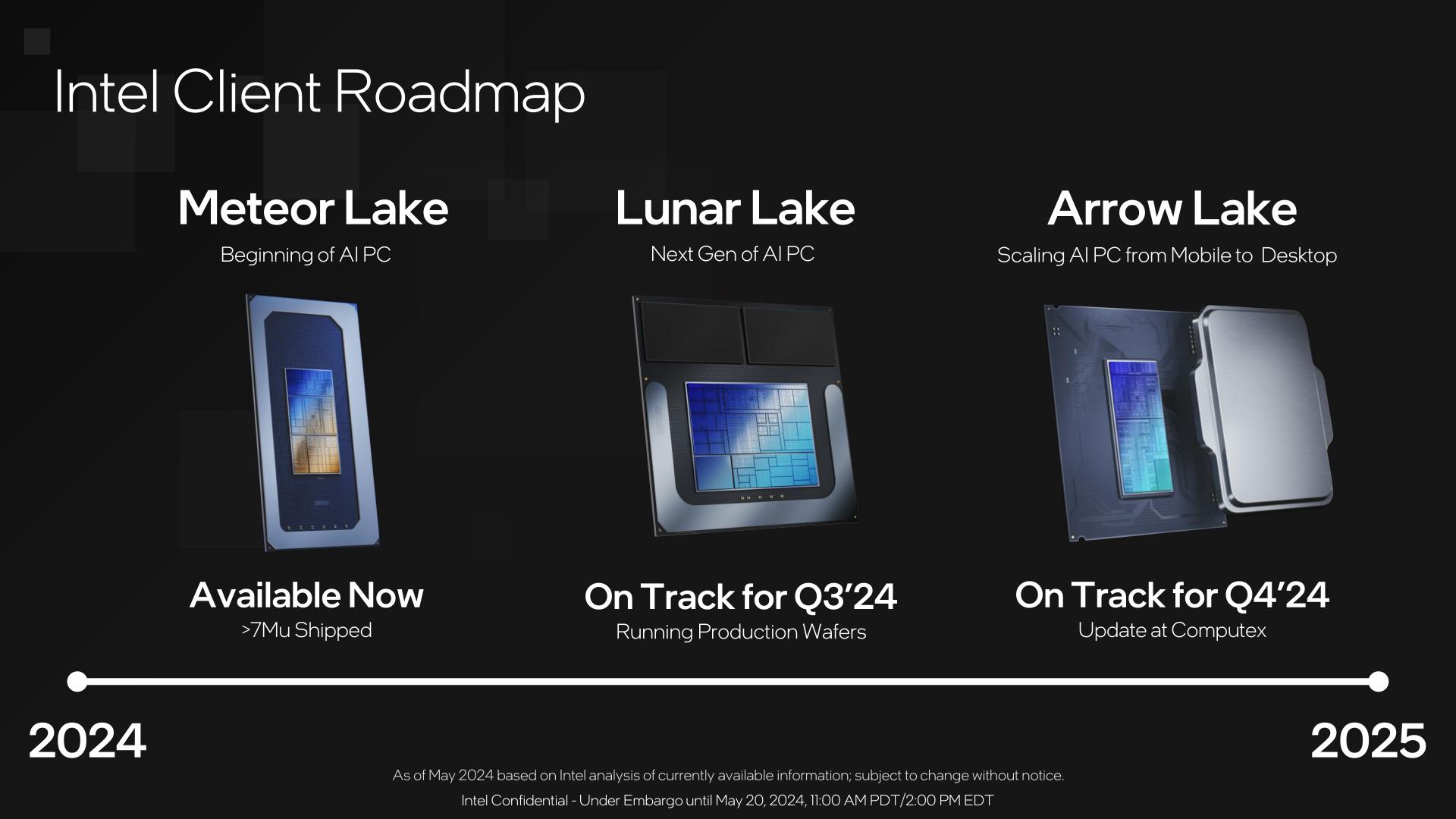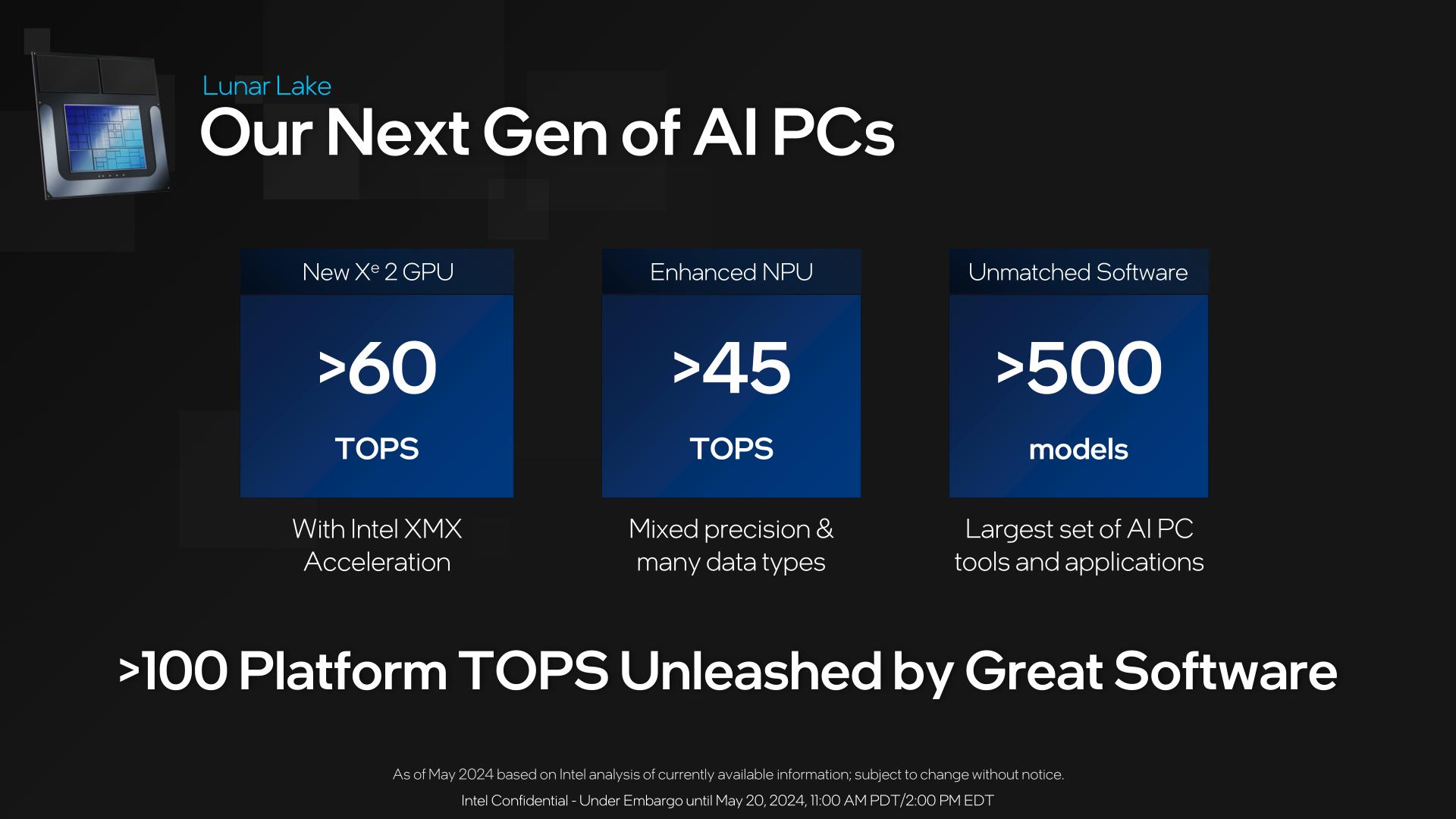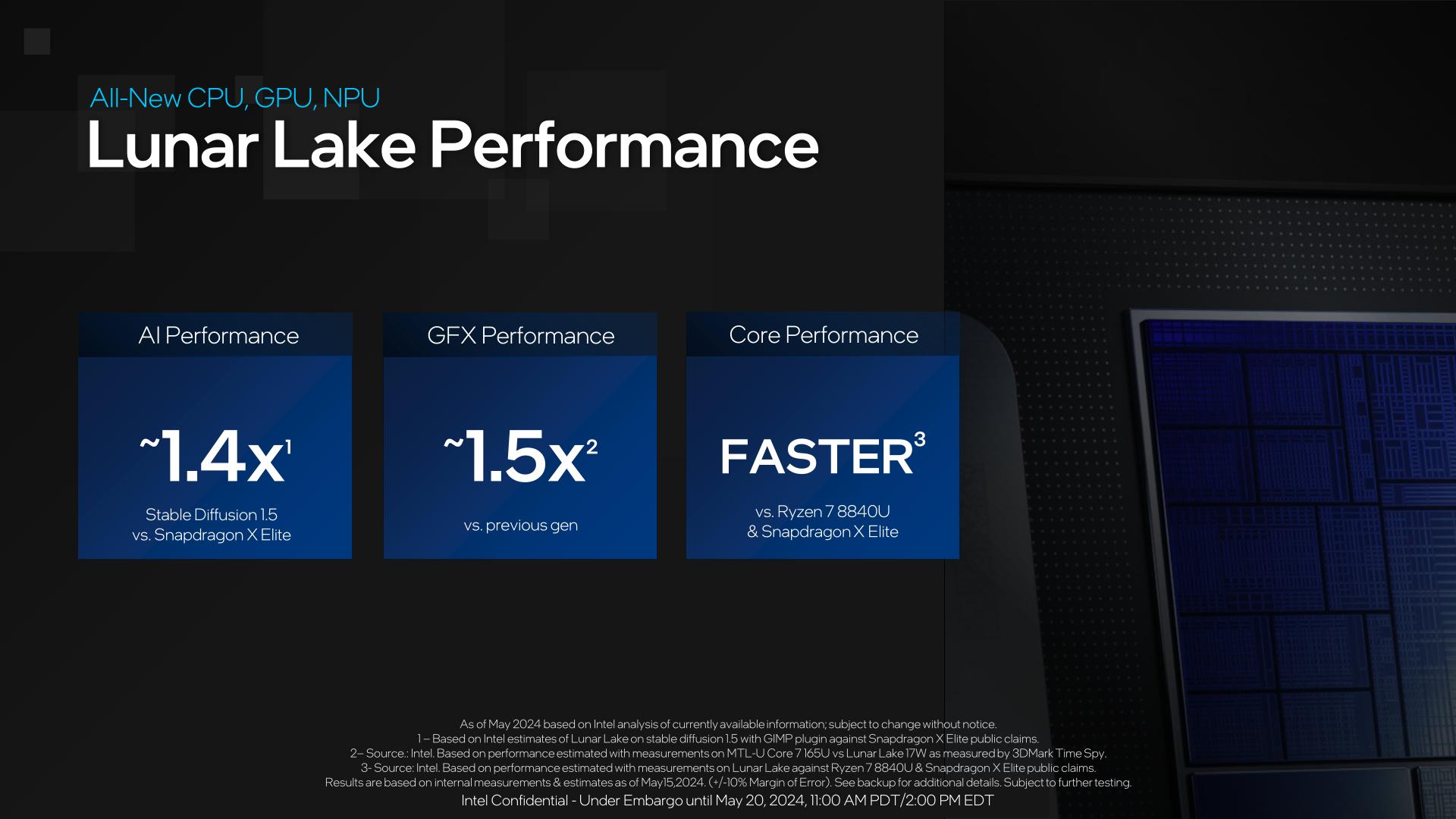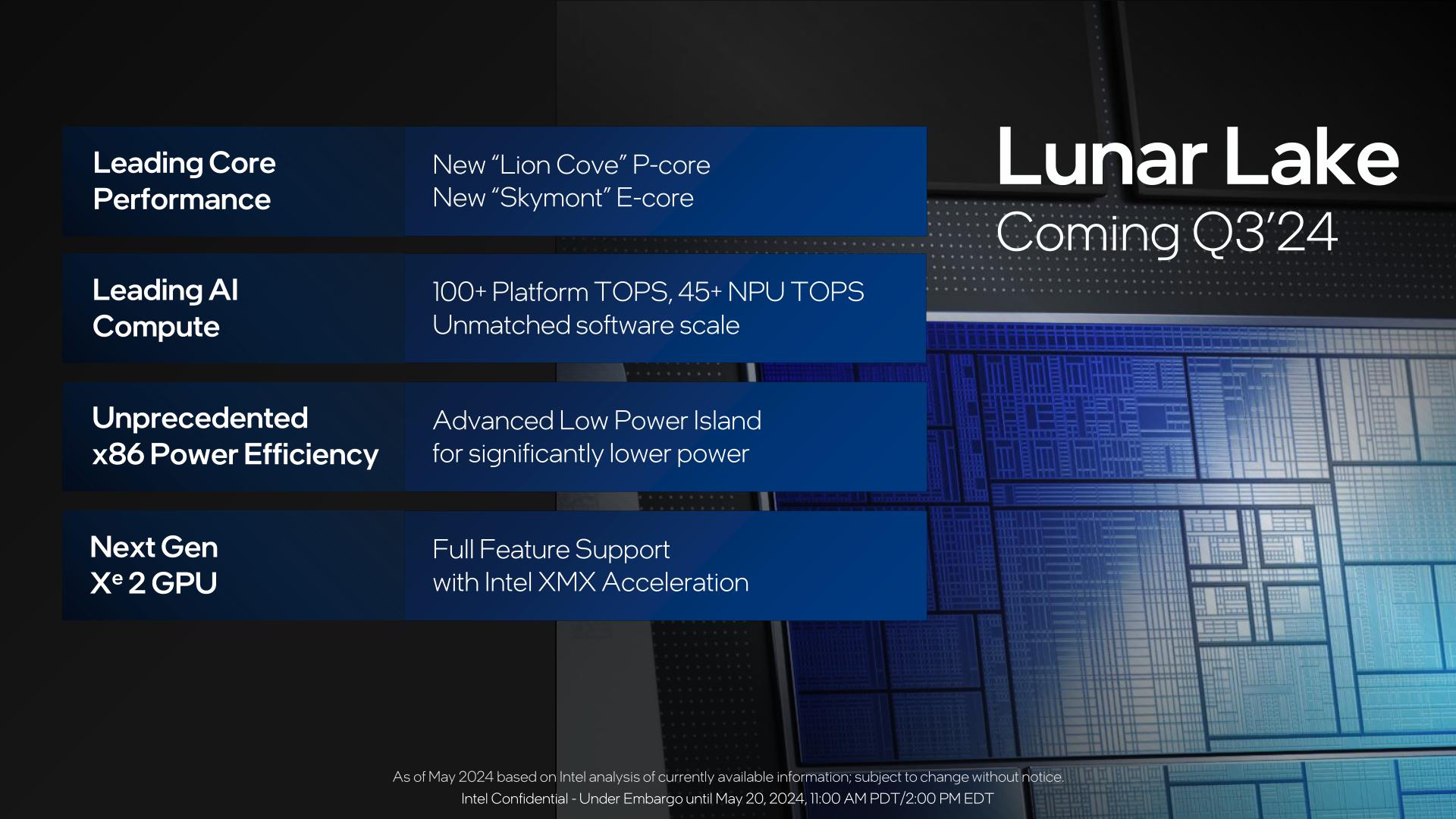The next few weeks in the PC industry are going to come fast and furious. Between today and mid-June are multiple conferences and trade-shows, including Microsoft Build and the king of PC trade shows: Computex Taiwan. With all three PC CPU vendors set to present, there’s a lot going on, and a lot of product announcements to be had. But even before those trade shows start, Intel is looking to make the first move this afternoon with an early preview on its next-gen mobile processor, Lunar Lake.
While Intel hasn’t said too much about what to expect from their Computex 2024 keynote thus far, it’s clear that Intel’s next-gen CPUs – Lunar Lake for mobile, and Arrow Lake for Mobile/Desktop – are going to be two of the major stars of the show. At this point Intel has previously teased and/or demoed both chips (Lunar more so than Arrow), and this afternoon the company is releasing a bit more information on Lunar Lake even before Computex kicks off.
Officially, today’s reveal is a preview of Intel’s next Tech Tour event, which is taking place at the end of May. Unofficially, this is the exact same date and time as the embargo on Qualcomm Snapdragon X laptop announcements, which are slated to hit retail shelves next month. Lunar Lake laptops, by contrast, will not hit retail shelves until Q4 of this year. So although the additional technical details from today’s disclosure are great to have, looking at the bigger picture it’s difficult to interpret this reveal as anything less than a bald-faced effort to interdict the Snapdragon X launch (not that Qualcomm hasn’t also been crowing about SDX for the last 7 months). Which, if nothing else, goes to show the current tumultuous state of the laptop CPU market, and that Intel isn’t nearly as secure in their position as they have traditionally been.
And with that out of the way, let’s dive into the meat of Intel’s announcement.
Lunar Lake: New Architecture Focused on Power Efficiency & AI
Ever since it was initially demoed by Intel last fall, the company has been promoting Lunar Lake as a highly efficient mobile processor. And that remains the story today. The low-power successor to Meteor Lake, Lunar Lake is Intel’s second mainstream tiled CPU, and will see Intel bringing new CPU and GPU architectures to bat in an iterative improvement over Meteor Lake.
And while Intel isn’t throwing out Meteor Lake quite yet, by Intel standards it’s going to have a relatively short shelf-life. From a high-level roadmap perspective, the groundbreaking tiled chip was late, and consequently as Intel Foundry works to catch up via its 5 Nodes in 4 Years (5N4Y) manufacturing strategy, Intel isn’t going to wait to bring out their next chips. They can’t; not with AMD and now Qualcomm both making serious efforts to cut into Intel’s mobile market share.
Development on Lunar Lake is already complete, with Intel claiming that they meet or beat all of their production milestones for the chip. This also means that Lunar Lake is already in production, using a B-stepping design.
Intel expects to begin shipping the SoC to OEMs in Q3 of this year, which means finished laptops will reach retail shelves in Q4 – though at this point it’s unclear if that will be early or late into the quarter. Meanwhile, Arrow Lake, which is going to be both for desktop and mobile usage (as a higher performance chip), is set to ship from Intel in Q4. We’re told we’ll find out more about Intel’s plans there at Computex.
| Intel CPU Architecture Generations | |||||
| Alder/Raptor Lake | Meteor Lake |
Lunar Lake |
Arrow Lake |
Panther Lake |
|
| P-Core Architecture | Golden Cove/ Raptor Cove |
Redwood Cove | Lion Cove | Lion Cove | Cougar Cove? |
| E-Core Architecture | Gracemont | Crestmont | Skymont | Crestmont? | Darkmont? |
| GPU Architecture | Xe-LP | Xe-LPG | Xe2 | Xe2? | ? |
| NPU Architecture | N/A | NPU 3720 | ? | ? | ? |
| Active Tiles | 1 (Monolithic) | 4 | 2 | 4? | ? |
| Manufacturing Processes | Intel 7 | Intel 4 + TSMC N6 + TSMC N5 | Intel + TSMC? | Intel 20A + More | Intel 18A |
| Segment | Mobile + Desktop | Mobile | LP Mobile | HP Mobile + Desktop | Mobile? |
| Release Date (OEM) | Q4’2021 | Q4’2023 | Q3’2024 | Q4’2024 | 2025 |
Despite all of this, Intel has still not confirmed what manufacturing processes are being used for Lunar and Arrow Lake. As part of Intel’s efforts to right themselves and separate their Foundry and Products businesses, Intel’s chip design groups are free these days to pick whatever fab they’d like – which in practice means using TSMC to produce some of their dies, as what happened with Meteor Lake. So we remain in the dark on which parts of the chips are being fabbed where.
For today’s preview, Intel is using the same Lunar Lake die diagram as they used at Intel Vision last month. This shows a more compact design with 3 tiles – SoC (top), compute (bottom), and then a third empty tile that is presumably being used as structural silicon. This is down from 4 active tiles on Meteor Lake.
Given Intel’s energy efficiency focus, fewer tiles is not surprising to see. Even with the ultra-short distanced enabled by Foveros/EMIB 2.5D packaging, moving data off of a die remains a very power-expensive process, so there are some significant energy benefits to keeping things within a die as much as possible. This is also part of the reason we’re seeing on-package LPDDR5X memory for Lunar Lake, as this cuts down on the memory bus length while making the overall SoC + RAM package more compact.
As expected, Lunar Lake is getting new P-core and E-core architectures, which are further evolutions of Intel’s Cove and Mont CPU core lineups. The P-cores will be the new Lion Cove architecture, while the E-cores get Crestmont’s successor, Skymont.
While Intel isn’t going into deep detail on these architectures today, what they are promising is being positioned as a significantly bigger step up than what Meteor Lake (Redwood Cove/Crestmont) delivered, with Intel being extremely optimistic about CPU core performance. Both the P and E-cores will deliver significant IPC and performance-per-watt improvements – and even if the latter comes entirely from process node improvements, IPC improvements hint at greater internal changes.
The footnotes of Intel’s presentation also confirm that at least one SKU configuration for Lunar Lake will be a 4P + 4E design, with an undisclosed number of low-power E-cores. Meteor Lake-U, by comparison, is 2P + 8E + 2LP. Ignoring the LP cores for the moment, that means Lunar Lake is ending up with two fewer CPU cores overall, but it’s getting twice as many P cores. Overall, it’s a much more balanced design than the E-core-heavy designs of Meteor Lake and Alder/Raptor Lake.
The mobile chip will also come with a new GPU architecture, Xe2. This is the same GPU architecture as will be featured on Intel’s forthcoming Battlemage discrete GPUs.
Details on Xe2/BM are slim, but most notably, the implementation going into Lunar Lake is getting Intel’s Xe Matrix eXtention (XMX) cores, which have been a feature of the architecture since Alchemist, but not included with the Xe-LPG design used for Meteor Lake. This change should bring Intel’s iGPU closer to feature parity with its desktop counterparts, as well as giving it the means to run the high-quality version of Intel’s XeSS temporal image upscaling technology. Meanwhile the new iGPU should also deliver a 50% increase in raster graphics performance, for a sizable boost in the pixel pushing power of the pint-sized chip.
And in this era of AI everywhere, we’d be remiss not to mention the AI potential for the XMX cores. These give Lunar Lake yet another high-performance processing block to run neural networking computations, with an expected performance of over 60 TOPS (INT8).
Lunar Lake is also getting a new NPU, though Intel hasn’t gone into any architectural details here (or even named it). As previously disclosed by Intel, the Lunar Lake NPU is rated for a minimum of 45 TOPS at INT8 precision, over 3x the throughput of Meteor Lake’s 11 TOPS NPU. The overall performance of the entire chip, meanwhile, is expected to reach over 100 TOPS.
At this point, Intel, Qualcomm, and AMD are all simultaneously promoting AI workloads as the next big thing and squabbling over who has (or will have) the best NPU. Intel expects Lunar Lake to lead in raw performance, but they also are pushing the software angle pretty hard, outlining their toolset and developer support. No one in the industry seems particularly happy with TOPS comparisons right now (not the least of which is because all the same players regularly fail to disclose at what precision), but until the first killer app comes along that they can use as a meaningful benchmark, we’re going to continue to see raw throughput figures thrown around.
Otherwise, the final and biggest push on the architectural side of Lunar Lake is power efficiency and battery life. While Meteor Lake and Alder/Raptor lake have been okay in these departments, Intel hasn’t had a product that’s truly knocked things out of the park since Tiger Lake in 2020. And everyone is still chasing the Apple M-series, which is now on its fourth iteration. Lunar Lake is dedicated mobile silicon that’s been designed in particular for low-power devices, so Intel is expecting to deliver significant gains here (and fend off their competition), with Intel product managers calling it a “transformative moment for x86 power consumption.”
More details on how Intel is accomplishing this are to come, but a big part of that appears to be the new SoC die and its low power island. According to Intel the new chip will improve on every aspect of power efficiency, including what’s arguably the most critical aspect for them at this point, idle power consumption.
Performance Expectations
Finally, Intel is publishing brief set of performance slides for Lunar Lake, outlining their performance and battery life expectations versus themselves, as well as both AMD and Qualcomm. With the latter’s laptops not yet shipping, all of this should be taken with multiple grains of salt as things can and do change over time. But for now, we have performance slides to fight other performance slides.
It should be noted that Intel’s footnotes indicate they’ve tested Lunar Lake systems at both 17W and 30W (complete chip power, including DRAM). Though other than their graphics performance claims, Intel hasn’t made it clear which TDP configuration was used for which test. So for the time being, we’re assuming everything is with Lunar Lake at 30W unless otherwise noted.
Underscoring today’s themes, Intel goes right for a Qualcomm AI performance comparison, claiming that they can beat their southern neighbors by 40% in Stable Diffusion 1.5 running on the GIMP photo editor. One of Qualcomm’s favorite benchmarks, Intel reports that this is in comparison to Qualcomm’s published figures. Similarly, Intel claims they have the lead over both the Snapdragon X Elite and AMD’s Ryzen 7 8840U based on undisclosed performance estimates.
Finally, in GPU performance comparing 17W Lunar Lake versus 15W Meteor Lake Core 7 165U, Intel is seeing 50% better performance in 3DMark Time Spy, a raster-only workload.
And for power consumption, Intel put together a workload in Microsoft Teams that involves 9 video windows with AI effects (Windows Studio Effects) layered on top. This was a metered test using hardware in Intel’s labs, so the comparisons here are the Ryzen 7 7840U and Qualcomm’s antiquated Snapdragon 8cx Gem 3. Unsurprisingly, Intel has the lead here, and this is despite the handicap of package power measurements for Lunar Lake including the memory while the Ryzen and Snapdragon do not. Unfortunately, Intel is not releasing any data comparing Lunar Lake’s power consumption to Meteor Lake.
Lunar Lake: Retail Devices Coming in Q4
Wrapping things up, today’s disclosures on Lunar Lake are the tip of the iceberg – designed to whet the appetite – ahead of Computex and beyond. With Intel holding their Tech Tour event at the end of this month, and then a Computex keynote a few days later, Intel will be providing significantly more details in short order – as will the rest of their competitors, for that matter.
Beyond those events, Intel intends to start shipping Lunar Lake processors to OEMs in Q3 of this year. This will get laptops out in Q4, just in time for the all-important holiday period.








